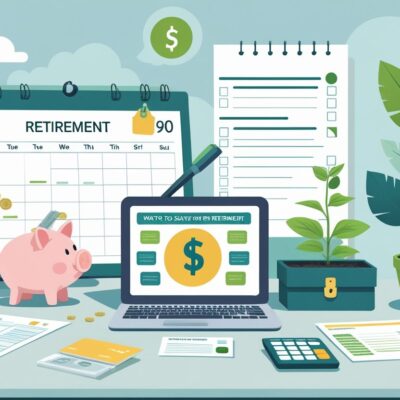Retirement planning isn’t just about crunching numbers or checking boxes—it’s about taking real steps to make sure you’re comfortable later on. Most folks aren’t totally sure where to begin, or they get overwhelmed by all the options out there. That confusion? It can lead to putting things off, which makes it harder to catch up down the road.
There’s no magic bullet, but being intentional—maxing out contributions, diversifying, and protecting what you’ve saved—can really change your financial future. Let’s look at some practical ways to build up that retirement nest egg, from using smart tax-advantaged accounts to setting up automatic savings and keeping your investments on track. None of this is rocket science, but it does take some action.
1) Start contributing to a Roth IRA for tax-free growth potential

Roth IRAs are pretty special when it comes to tax perks. You pay taxes on your money up front, but then your investments grow and you won’t owe a dime in taxes when you pull the money out in retirement.
Your money grows in the account year after year, untouched by annual taxes. Over decades, that can add up to a lot more compared to regular taxable accounts.
If you start early, the benefits really pile up. Someone who starts at 25 and puts in $7,000 a year with 7% growth could see their account reach over $1.3 million by 65—and all of that growth would be tax-free.
You can make qualified withdrawals after you turn 59½, as long as the Roth IRA has been open for five years. At that point, you get both your contributions and your earnings tax-free.
Here’s something people often overlook: Roth IRAs don’t force you to take money out at a certain age. That means you can let your savings keep growing as long as you want.
And unlike some other retirement accounts, you can keep contributing to a Roth IRA past age 70½. That gives you a longer runway to build up your savings, if you want.
2) Maximize your 401(k) contributions especially if there is an employer match

Employer matches on 401(k)s are basically free money—seriously, don’t leave that on the table. When your company offers to match your contributions, they’re literally adding to your retirement fund just because you’re saving for yourself.
Most companies that offer 401(k)s will match at least part of what you put in. It’s a win-win: they get loyal employees, and you get a bigger retirement pot.
The trick is to contribute at least enough to grab the full match. If you can’t swing 10-15% of your salary, at least hit the match threshold so you’re not missing out.
For 2025, you can put up to $23,500 into your 401(k). If you’re 50 or older, you get to add even more—$7,500 in catch-up contributions, or $11,250 if you’re between 60 and 63.
Take a look at what you’re putting in now and see if you can bump it up, even just a little. Over time, those small increases (plus the match) can really boost your savings.
One thing to watch: some employers have vesting schedules. You might need to stick around for a certain number of years before all the matching money is officially yours.
3) Establish an emergency fund to avoid dipping into retirement savings
An emergency fund is your safety net—it keeps you from raiding your retirement accounts when life throws a curveball. Having a separate stash of cash means your long-term investments can keep growing, untouched.
If you don’t have that cushion, it’s way too easy to dip into your retirement savings or take out loans against them. Not only do you get hit with penalties and taxes, but you also lose out on the growth that money would have had.
Retirees, in particular, need that buffer. Medical bills, home repairs, and other surprises can hit hard when you’re living on a fixed income.
When markets drop, you don’t want to be forced to sell investments at a loss just to cover an emergency. That’s where the emergency fund saves the day.
Experts usually suggest keeping your emergency cash in a separate, easy-to-access account, not mixed in with your retirement investments. That way, it’s there when you need it, and your long-term savings stay on track.
4) Automate monthly transfers to a dedicated retirement savings account
Setting up automatic transfers is a game-changer. You don’t have to remember to save each month—the money just moves from checking to retirement savings, no extra effort required.
Most banks let you schedule these transfers. You pick the amount and the timing, maybe right after payday so you don’t even notice it’s gone.
Automation makes it a lot harder to spend that money on something else. It’s out of sight, out of mind, and working for your future instead of getting lost in daily expenses.
Those regular, automated deposits add up over the years. Even if you start small, consistency is what matters most.
Putting your automated savings into 401(k)s or IRAs also brings tax benefits and better growth potential than just using a regular savings account.
Once you set it up, you can mostly forget about it. If your income changes, you can tweak the amount, but otherwise, just let it ride.
Honestly, even $50 or $100 a month makes a big difference over decades. The key is to start and let time do the heavy lifting.
5) Diversify investments with a mix of stocks, bonds, and index funds
Diversifying your investments helps protect your retirement savings from the market’s ups and downs. A good mix of stocks, bonds, and index funds spreads out your risk.
Stocks are the growth engine—they can help your money outpace inflation, but they do bounce around a lot.
Bonds bring some calm to the ride. They don’t grow as fast as stocks, but they provide steady income and help preserve your capital.
Index funds are an easy way to diversify without a ton of hassle or high fees. They let you invest in a broad slice of the market all at once.
Your ideal mix depends on how much risk you’re comfortable with, how long you have until retirement, and your personal goals. If you’re younger, you can usually handle more stocks; as you get closer to retirement, it makes sense to add more bonds.
It’s smart to gradually shift your investments as retirement approaches, dialing back risk but still keeping some growth in the mix.
Rebalancing now and then keeps your portfolio on target. If one part grows too much, sell a bit and buy what’s lagging to get back to your planned allocation.
6) Regularly review and rebalance your portfolio to maintain risk levels
Rebalancing your portfolio helps you stick to your preferred risk level. As markets move, your investments can drift from your original plan, which might expose you to more risk than you’re comfortable with.
When stocks do well, they can start to dominate your portfolio; if other assets lag, you might end up way off-balance.
To rebalance, you sell a little of what’s grown too much and buy more of what’s lagged behind. This gets your portfolio back in line with your goals.
It’s a good idea to check in on your mix regularly and see if it still fits your risk tolerance. Life changes, and your strategy should too.
Some folks set thresholds—maybe if an asset class moves 5-10% away from its target, it’s time to rebalance. That keeps things from drifting too far off course.
There are even automated tools that can rebalance for you, taking the emotion out of those decisions and making sure you stay on track.
Each time you rebalance, take a moment to think about your overall strategy. Does it still fit your retirement timeline and your goals? Adjust as needed.
Understanding Retirement Savings
Building retirement wealth really comes down to starting as early as you can and letting compound growth work its magic. Time is your best friend here—those small, regular contributions can snowball into something huge if you give them enough years.
The Importance of Early Planning
If you start saving in your 20s or 30s, you give your money decades to grow. Someone who puts away $200 a month starting at 25 will end up with a lot more than someone who waits until 40, even if the late starter tries to catch up with bigger payments.
Why starting early helps:
- You don’t have to save as much each month
- You have more time to recover from market dips
- You get more flexibility with investments
- You’ll probably stress less about money later on
The government encourages long-term saving by offering special retirement accounts with tax breaks—things like 401(k)s, traditional IRAs, and Roth IRAs. Each one has its own perks.
If you put off retirement planning, you might find yourself in a tough spot. Working longer, cutting back your lifestyle, or scrambling to save more later aren’t fun options.
How Compound Interest Works in Retirement Accounts
Compound interest is the secret sauce of retirement savings. Your investments earn money, and then that money earns even more money. Over time, it really adds up.
Here’s a simple example: $1,000 invested at 7% becomes $1,070 after a year. The next year, you earn 7% on $1,070, not just the original $1,000. That extra $4.90? That’s compound growth doing its thing.
What makes compounding work best?
- Higher returns: The more you earn, the faster it grows
- More time: The longer you leave it, the bigger it gets
- Regular contributions: Keep adding, and it compounds even faster
- Tax advantages: Tax-deferred growth means you keep more working for you
At a 7% annual return, your money doubles about every 10 years. So $10,000 at age 25 could turn into $80,000 by 55, even if you don’t add another penny.
Tax-advantaged accounts help compounding work even better. Traditional 401(k)s and IRAs let your money grow tax-deferred, while Roth accounts give you tax-free growth and withdrawals later on.
Common Challenges in Saving for Retirement
Rising costs and everyday bills make it tough to save for the future. Balancing immediate needs with long-term goals isn’t easy, and it’s a big reason why so many people feel behind on retirement.
Inflation and Cost of Living
Inflation quietly eats away at your spending power over time. What costs $1,000 today might run you $1,800 in 20 years. That’s a big deal when you’re planning for a long retirement.
Historically, inflation averages about 3% a year, but healthcare costs often rise even faster—sometimes 5-6% annually.
What inflation means for your retirement:
- Your savings won’t stretch as far in the future
- You’ll need to aim for a bigger nest egg
- Replacing your income gets trickier as costs rise
Plenty of retirement calculators don’t factor in inflation properly, so it’s smart to increase your savings rate every now and then to keep up.
Social Security does adjust for inflation, but those increases might not fully cover rising expenses—especially for things like healthcare or housing.
Balancing Immediate Expenses with Long-Term Goals
Everyday financial demands—rent or mortgage, student loans, childcare, and those surprise emergencies—can make it tough to prioritize retirement savings. It’s a lot, honestly.
The median household spends about 30% of their income just on housing. Toss in transportation, groceries, insurance, and monthly debts, and, well, there’s not a whole lot left for the future.
Common Competing Priorities:
- Mortgage payments and home maintenance
- Children’s education expenses
- Emergency fund building
- High-interest debt elimination
Some financial pros suggest the 50/30/20 rule: half your income for needs, 30% for wants, and 20% for savings or debt. In reality, though, hitting those numbers isn’t easy for most families.
Young adults especially get hit hard by student loans and entry-level pay. Many put off saving for retirement, even though those early years matter most for long-term growth. It’s kind of a catch-22, isn’t it?
Setting up automatic payroll deductions can make saving less of a chore. Even small amounts add up over time and snag any employer match that’s on the table. It might not feel like much, but it’s a start.




